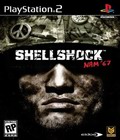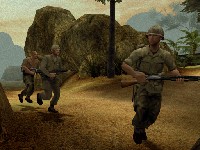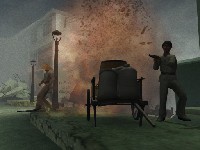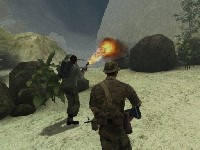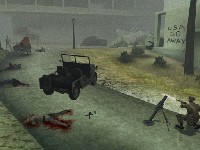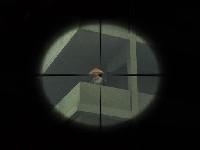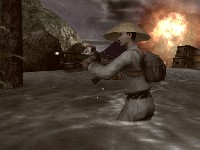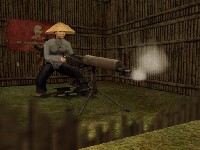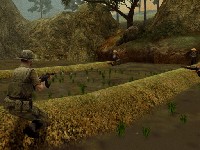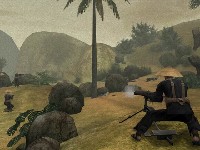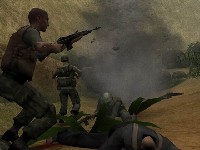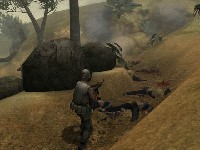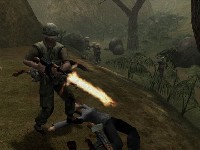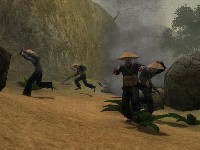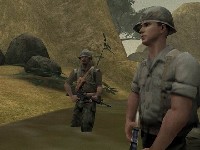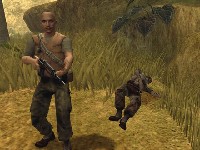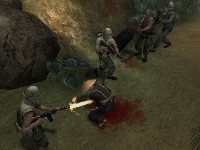
Genre: Action
Publisher: Eidos Interactive
Developer: Guerrilla
Release Date: September 7, 2004
Buy 'SHELLSHOCK: Nam '67':
Xbox | PC | PlayStation 2
The United States has several key dates that we as residents will never forget, like the 9/11 terrorist attacks and the December 7th bombing of Pearl Harbor in 1941. One that we would probably like to forget was the day we got involved in the Vietnam War – "The first war that the United States ever lost" – which began in 1954 and finally ended in 1963 with the withdrawal of American troops. ShellShock: Nam '67 is a story of the young recruits who were in this war.
In this third-person shooter, you play as a newly drafted recruit sent to eliminate the communist threat. Equipped with your standard protocol, you try to survive through the deadly traps set by the VC and come home in one piece.
The game starts with a brief introduction and historical overview about the Vietnam War, and it's done quite well, allowing the gamer to experience a sense of realism and putting us in the position the soldiers were in. These scenes are recreated in black and white, which at times I mistake as video feeds rather than character models. To add to the realism, the songs in the game seem to fit perfectly for that time period.
ShellShock only has a single player campaign, which is quite odd because shooters are usually geared at multiple players, but I can only assume that Guerrilla wanted to put their focus on recreating a true Vietnam experience. In this regard, they did a superb job, recreating the sense of urgency that soldiers must have felt when having to avoid traps, fighting fierce tunnel battles, and almost always being outnumbered and at a disadvantage. They also added the fact that during this war, the soldiers could never tell who was friend or foe. If you let a regular citizen live, you would never know if he would come back to hurt you.
You will experience this firsthand in the second mission, where you are given the task of rounding up villagers and find the weapons cache. This will force the villagers to revolt and start attacking so it's either kill or be killed. The revolt wasn’t difficult to squelch after you pick up a hidden rocket launcher, but finding the weapons cache was actually the hardest part of the mission. The mission actually consisted of two parts: round up the villagers and find the cache. The first objective was easy because you just run towards them, and that would be considered done, but finding the cache wasn't quite so straightforward. On the screen, these objectives were hidden in hay stacks, but it was hard to understand what we were supposed to do with them. It took me a few tries to finally come up with the idea that they wanted us to burn them, which shows how intuitive the system is, but certainly requires some time to get acquainted.
The controls are a bit like SOCOM's: triangle to crouch, circle to reload, X to use, and square to quick switch. The other buttons and triggers allow you to: bead, lie prone, sprint, access inventory, use equipped item, access binoculars, peer or zoom in and out, change firing rate, and view mission intel.
Once you understand these basic controls, you can then learn the more advanced controls, such as picking up enemy weapons or dropped items, and more importantly, how to interact with key objectives as well as disarming traps. Traps are disarmed by entering a directional pad sequence quickly and correctly. You are still safe if you miss once or twice, but too many times, and it will blow on you. Disarming traps is probably the easiest objective in this game; the hardest ones involve actually defeating the enemy.
The reason behind this is because the sensitivity and firing for the game is not nearly as accurate as other first- or third-person shooters. Personally, I find SOCOM's system much better, since it is so much easier to aim. In ShellShock, accuracy is actually quite hard to achieve, taking a good five seconds to move the cursor over your desired target, during which you lose valuable time and health. This is, of course, when you are equipped with a gun. In certain missions, you may be equipped with only a knife and need to stealthily kill enemies that way (done by going behind an unaware enemy and pressing the R1 button). After playing a bit, I strongly suggest that players leave on the auto-aim and auto-center options.
Aside from the aiming problem, there is another big glitch in the game, and that's the inability to jump or climb over objects. When you see a log in front of you, I, for one, would want to climb over it rather than try to find the long, obscure path around it. Even though the maps seem large and wide, the inability to climb or jump onto or over small objects makes this game quite limited and unbelievably frustrating. I surely hope Killzone isn’t the same way, since jumping has always been a key feature in shooters and something that should not be taken away.
When resting at camp, soldiers can purchase necessities like drugs, postcards, and female companionship. You can pass the time with the prostitutes, or you can try hitting on the nurses, although they only go for the hotshots. You will also gain chit, money given out to soldiers during time of war, when selling souvenirs collected during the missions.
The best part of the game is probably the sounds. The voices fit the characters well and make it seem like something you would experience if we were actually on the battlefield. The machine gun fire, grenades and napalm also add to the experience. The music soundtrack is probably the best facet of the game because it adequately reflects the time period and perfectly suits the title.
While they aren't trailblazing, the graphics in the game are adequate. The controls aren't very smooth so the character movement doesn’t really feel right, and if you have motion sickness, I strongly suggest staying away from this game. The cut scenes are nicely done, the background is pretty detailed, and weapons seem to be faithful depictions of the available guns from that era. My favorite weapon is the Deathgun, a fully automatic machine gun that wreaks havoc on the enemy, although you must beware of it overheating. Maps range from jungle warfare to battles in the trenches or tunnels. Another plus are the explosions, which you can see and feel a dualshock controller. Depending on how close the explosion is, your screen may even go white. Aside from these bits of eye candy, the important graphical element on which you should always keep a watchful eye is your HUD. It includes a compass with objective locations, the top left corner features your health and stamina meters, the bottom left shows equipped weapon, ammo, and fire mode, and at times, you may also see an icon that shows a grenade has been thrown in your vicinity. Lastly, and most importantly, you should focus on the yellow and red bars that show from which direction an enemy is firing at you.
Overall, I feel that ShellShock: Nam '67 had some great concepts and did a great job of realistically recreating a very controversial war. As the game starts, it states that this is purely fictional, but you still wonder if there were similar missions that the recruits had to go through. However, with sluggish movement and imprecise aiming, the game does not meet shooter standards, and to make things worse, the terrain is limited and may give you a tough time in finding the way around blocked objects. With only 11 missions, this game is more of a rental than a purchase candidate. You may not find another game that represents war like this one, but with its downfalls, it's not a must-have.
Score: 6.0/10
More articles about ShellShock: Nam '67











